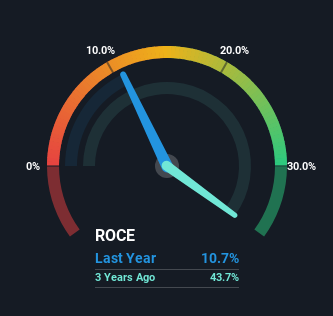Returns On Capital At Erayak Power Solution Group (NASDAQ:RAYA) Paint A Concerning Picture
What trends should we look for it we want to identify stocks that can multiply in value over the long term? Firstly, we'll want to see a proven return on capital employed (ROCE) that is increasing, and secondly, an expanding base of capital employed. Basically this means that a company has profitable initiatives that it can continue to reinvest in, which is a trait of a compounding machine. Having said that, from a first glance at Erayak Power Solution Group (NASDAQ:RAYA) we aren't jumping out of our chairs at how returns are trending, but let's have a deeper look.
Return On Capital Employed (ROCE): What Is It?
If you haven't worked with ROCE before, it measures the 'return' (pre-tax profit) a company generates from capital employed in its business. Analysts use this formula to calculate it for Erayak Power Solution Group:
Return on Capital Employed = Earnings Before Interest and Tax (EBIT) ÷ (Total Assets - Current Liabilities)
0.11 = US$2.1m ÷ (US$35m - US$15m) (Based on the trailing twelve months to June 2023).
Therefore, Erayak Power Solution Group has an ROCE of 11%. In absolute terms, that's a pretty normal return, and it's somewhat close to the Electrical industry average of 13%.
See our latest analysis for Erayak Power Solution Group
Above you can see how the current ROCE for Erayak Power Solution Group compares to its prior returns on capital, but there's only so much you can tell from the past. If you'd like, you can check out the forecasts from the analysts covering Erayak Power Solution Group here for free.
What Does the ROCE Trend For Erayak Power Solution Group Tell Us?
When we looked at the ROCE trend at Erayak Power Solution Group, we didn't gain much confidence. Around three years ago the returns on capital were 44%, but since then they've fallen to 11%. Although, given both revenue and the amount of assets employed in the business have increased, it could suggest the company is investing in growth, and the extra capital has led to a short-term reduction in ROCE. And if the increased capital generates additional returns, the business, and thus shareholders, will benefit in the long run.
On a side note, Erayak Power Solution Group has done well to pay down its current liabilities to 44% of total assets. That could partly explain why the ROCE has dropped. Effectively this means their suppliers or short-term creditors are funding less of the business, which reduces some elements of risk. Some would claim this reduces the business' efficiency at generating ROCE since it is now funding more of the operations with its own money. Keep in mind 44% is still pretty high, so those risks are still somewhat prevalent.
Our Take On Erayak Power Solution Group's ROCE
While returns have fallen for Erayak Power Solution Group in recent times, we're encouraged to see that sales are growing and that the business is reinvesting in its operations. But since the stock has dived 79% in the last year, there could be other drivers that are influencing the business' outlook. Regardless, reinvestment can pay off in the long run, so we think astute investors may want to look further into this stock.
One final note, you should learn about the 3 warning signs we've spotted with Erayak Power Solution Group (including 1 which can't be ignored) .
For those who like to invest in solid companies, check out this free list of companies with solid balance sheets and high returns on equity.
Have feedback on this article? Concerned about the content? Get in touch with us directly. Alternatively, email editorial-team (at) simplywallst.com.
This article by Simply Wall St is general in nature. We provide commentary based on historical data and analyst forecasts only using an unbiased methodology and our articles are not intended to be financial advice. It does not constitute a recommendation to buy or sell any stock, and does not take account of your objectives, or your financial situation. We aim to bring you long-term focused analysis driven by fundamental data. Note that our analysis may not factor in the latest price-sensitive company announcements or qualitative material. Simply Wall St has no position in any stocks mentioned.

